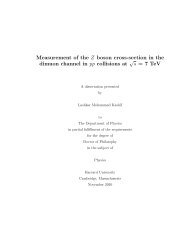2 The CDF Experiment at Fermilab Contents - Harvard University ...
2 The CDF Experiment at Fermilab Contents - Harvard University ...
2 The CDF Experiment at Fermilab Contents - Harvard University ...
You also want an ePaper? Increase the reach of your titles
YUMPU automatically turns print PDFs into web optimized ePapers that Google loves.
Section 2: Run II Discovery Physics 65<br />
2.4 Run II and Beyond<br />
<strong>The</strong> prospect of a much larger and improved d<strong>at</strong>a set raises hopes for the discovery of physics<br />
beyond the Standard Model. <strong>The</strong> <strong>Harvard</strong> group has set its sights on discovery physics and<br />
on measurements of CP viol<strong>at</strong>ion in the b system. We describe our plans and achievements<br />
in these two areas below.<br />
2.4.1 Discovery Physics<br />
<strong>The</strong>re are two approaches to searching for New Physics which are sometimes called \d<strong>at</strong>adriven"<br />
and \theory-driven." <strong>The</strong>y are somewh<strong>at</strong> opposed philosophically, and each has it<br />
advantages and disadvantages.<br />
<strong>The</strong> idea behind d<strong>at</strong>a-driven searches is th<strong>at</strong> a well-dened event sample thought to be<br />
explained by known processes should be studied thoroughly with an eye open for important<br />
discrepancies between observ<strong>at</strong>ion and expect<strong>at</strong>ion. For example, a valid measurement of<br />
the cross section for tt production, in principle a well-understood SM process, could turn<br />
out higher than expected. One would conclude th<strong>at</strong> the selected event sample would contain<br />
events from new physics processes. If the measurement were below expect<strong>at</strong>ion, then it could<br />
indic<strong>at</strong>e unusual top decays to st<strong>at</strong>es not s<strong>at</strong>isfying the given selection criteria. If pursued<br />
seriously and with alacrity, almost any measurement of SM processes could open a window<br />
to an unexpected discovery.<br />
<strong>The</strong> weakness of d<strong>at</strong>a-driven searches is the danger th<strong>at</strong> uctu<strong>at</strong>ions are innocently massaged<br />
into signals. This weakness is avoided in the theory-driven approach, in which a signal<br />
is proposed and modeled, allowing a priori selection criteria to be designed using simul<strong>at</strong>ions<br />
before the d<strong>at</strong>a are queried. In principle the criteria are unbiased with respect to fe<strong>at</strong>ures of<br />
the d<strong>at</strong>a, so when applied to the real d<strong>at</strong>a, a signicant excess of events is either observed, or<br />
not. In practice the diculty of modeling some of the backgrounds often precludes nalizing<br />
the selection criteria before the d<strong>at</strong>a are looked <strong>at</strong>. More importantly, the criteria designed<br />
for a signal suggested by a popular theory may fail to ferret out a real signal quite dierent<br />
from wh<strong>at</strong> th<strong>at</strong> theory predicts. In other words, there is a danger of looking very seriously<br />
and system<strong>at</strong>ically for the wrong signals.<br />
We do not wish to adopt a dogma for Run II. We believe th<strong>at</strong> the the job of the experimenter<br />
is to study the d<strong>at</strong>a and to see whether a given interesting sample can be fully<br />
understood. At the same time, current theoretical ideas about extensions of the SM are















